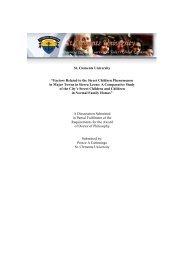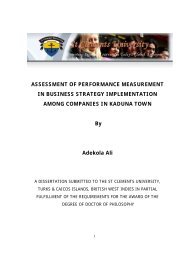Rufus Folorunso Akinyooye - St Clements University
Rufus Folorunso Akinyooye - St Clements University
Rufus Folorunso Akinyooye - St Clements University
Create successful ePaper yourself
Turn your PDF publications into a flip-book with our unique Google optimized e-Paper software.
The real reason however may have been given by Lutz (2000) who said the Basel 2 Accord is<br />
more of a co-operation between the regulators and the practitioners in the field rather than the<br />
regulators-only approach of the Basel 1 Accord. In her paper she examined the reasons for the<br />
transition from the first Accord to the second, which she said, was triggered by globalization.<br />
This globalization, she said was characterized by not only territorial expansion of economic<br />
activity but also by structural changes within international markets, combined with the<br />
emergence of qualitatively new forms of financing. She detailed three broad categories of<br />
development that characterized these structural shifts as:<br />
(1) An increasing share of financial intermediation taking place through capital markets<br />
as opposed to bank lending. Credit-worthy borrowers stated bypassing the banks<br />
to transform their liabilities into tradable securities known as Securitization. With<br />
declining loan business being continuously made unattractive by the Basel 1<br />
Accord provision especially as it affects exposures to third world countries after the<br />
Mexico debt crisis, commercial banks started expanding into more profitable lines<br />
of business like investment banking where profits are made through brokerage<br />
commissions instead of interest on credits.<br />
(2) Institutional investors like insurance companies, pension funds, or mutual funds<br />
became major players on the global securities markets.<br />
(3) The emergence of financial derivatives.<br />
With this scenario, the concept of regulatory capital required to cushion the effect of the<br />
newly identified risks changed, and since the banks were the inventors, the regulatory<br />
authorities had no choice but to partner with them in the task of calculating appropriate<br />
regulatory capital. The result was to eventually become the Basel 2 Accord. This explains<br />
Lutz (2000) argument that the Basel 2 Accord is a co-operation between the regulators and<br />
the practitioners in the field.<br />
THE BASEL 2 ACCORD- INTERNATIONAL CONVERGENCE ON CAPITAL<br />
MEASUREMENT AND CAPITAL STANDARDS- A REVISED FRAMEWORK<br />
Item 1 - Describes the Basel 2 Accord as the outcome of the Basel Committee on Banking<br />
Supervision work over recent years to secure international convergence on revisions to<br />
supervisory regulations governing the Capital adequacy of internationally active banks. It<br />
confirms the Accord and that<br />
the Central Bank Governors and Heads of Banking Supervision of the Group of Ten Countries<br />
have endorsed the <strong>St</strong>andard it contains.
















